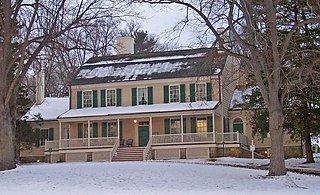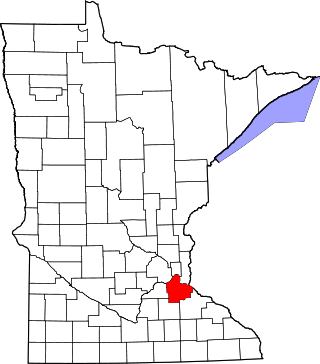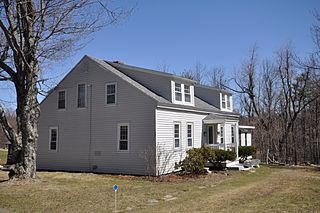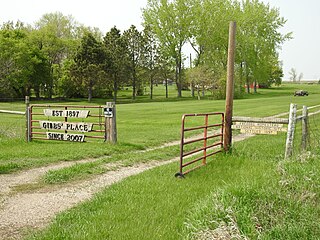
The Maj. James B. Bailey House is a historic home in Gainesville, Florida, United States. It is located at 1121 Northwest 6th Street. In 1972, it was added to the U.S. National Register of Historic Places.

John Alfred Pickler was an American politician. He served as a member of the United States House of Representatives.

The John Jay Homestead State Historic Site is located at 400 Jay Street in Katonah, New York. The site preserves the 1787 home of Founding Father and statesman John Jay (1745–1829), one of the three authors of The Federalist Papers and the first Chief Justice of the United States. The property was designated a National Historic Landmark in 1981 for its association with Jay. The house is open year-round for tours.

This is a list of the National Register of Historic Places listings in Dakota County, Minnesota. It is intended to be a complete list of the properties and districts on the National Register of Historic Places in Dakota County, Minnesota, United States. Dakota County is located in the southeastern part of the U.S. state of Minnesota, bounded on the northeast side by the Upper Mississippi River and on the northwest by the Minnesota River. The locations of National Register properties and districts for which the latitude and longitude coordinates are included below, may be seen in an online map.

The Frawley Ranch is an historic ranch in Lawrence County, South Dakota, near Spearfish, South Dakota. Henry Frawley developed what became the largest and most successful cattle ranch in western South Dakota by purchasing lands that had failed as smaller homesteading parcels. The property was declared a National Historic Landmark in 1977.

The Snake River Land Company Residence and Office are structures associated with John D. Rockefeller Jr.'s acquisition of land in Jackson Hole, Wyoming, United States. Under the guise of the Snake River Land Company, Rockefeller bought much of the land that he eventually donated to the National Park Service, first as Jackson Hole National Monument and a year later as Grand Teton National Park. The buildings are located in the park, in the community of Moran. They served as the residence and office for SRLC vice president Harold Fabian and foreman J. Allan from 1930 to 1945. The buildings are still used by the National Park Service. The property was owned from 1926 to 1930 by John Hogan, a retired politician from the eastern United States. The Snake River Land Company bought the property in 1930.

The Maj. Isaac C. Elston House, also known as Elston Homestead, is a historic home located at Crawfordsville, Montgomery County, Indiana, United States. It was the home of Maj. Isaac Compton Elston, who fought in the War of 1812 and the Black Hawk War. When he was 39, he moved to Indiana and became a frontier merchant, banker and financier. The Home was given to Wabash College by his grandson, Isaac Compton Elston, Jr. (1873-1964) and is now used as the President's home.

This is a list of the National Register of Historic Places listings in Beadle County, South Dakota.

The Maj. John Neff Homestead is an historic, American home and barn complex that is located in Potter Township, Centre County, Pennsylvania.

The Former North Dakota Executive Mansion, also or formerly known as Old Governor's Mansion or Asa Fisher House, at 320 Ave. B., E., in Bismarck, North Dakota, was built in 1893.

Joseph A. Shannon (1859-1934), known in at least one source as John A. Shannon, was an architect in Devils Lake, North Dakota.

The Maj. Gen. Lord Stirling Quarters, also known as the Homestead Farm (1880) and Echo Valley Farms (1926-1973), is an historic home that is located in Tredyffrin Township, Chester County, Pennsylvania.

The Maj. Gen. John Sedgwick House is a historic house at 52 Hautboy Hill Road in Cornwall, Connecticut. Built in 1859–60, it is a prominent local example of Italianate architecture, and was built by Union Army General John Sedgwick, one of Connecticut's leading figures in the American Civil War. The house was listed on the National Register of Historic Places in 1992.

The Prairie Homestead is a sod house located at 21070 South Dakota Highway 240 north of Interior, South Dakota. The house was constructed by Ed Brown and his wife in 1909. The Browns built their home with sod bricks and topped it with a grass roof. Western South Dakota was one of the last regions of the state to be settled by homesteaders, and the house is now one of the few remaining sod homes in the state. The home is now open to visitors for tours and houses farm animals and prairie dogs on its grounds.

The Benjamin Learned House is a historic house on Upper Jaffrey Road in Dublin, New Hampshire. Built in the late 1760s, it is one of the town's oldest surviving buildings. It is further notable for its association with the locally prominent Learned family, and for its role in the summer estate trend of the early 20th century. The house was listed on the National Register of Historic Places in 1983.
Zeona is an extinct town in Perkins County, in the U.S. state of South Dakota. The GNIS classifies it as a populated place.
The Ashley Jewish Homesteaders Cemetery is an early 20th century burial site near Ashley, North Dakota. The Russian and Romanian Jews who farmed the area beginning in 1905 arrived as refugees fleeing pogroms and persecution. They had never farmed before, due to restrictions against Jews owning land in their native countries. Despite this lack of experience and the many rocks and boulders that peppered their claims, with the assistance of their German-Russian neighbors, and hard work and persistence, the great majority of them were successful enough to buy their land outright prior to the five-year waiting period contained within the Homestead Act of 1862, or to own their land at the five year mark.

The Freborg Homestead near Underwood in McLean County, North Dakota was listed on the National Register of Historic Places in 2014. The listed property is 10.5 acres (4.2 ha) that includes the farm buildings, out of what once was a 160 acres (0.65 km2) homestead.
The Anderson Homestead, located in Clay County, South Dakota east of Hub City, South Dakota on the county line road between Clay County and Union County, South Dakota, dates from 1876. It was listed on the National Register of Historic Places in 1978. The listing included 13 contributing buildings, three contributing structures, and a contributing site.
The John Sloan Homestead is a historic house in Volin, South Dakota. It was built in 1881–1885 with chalk rock by John Sloan, who established the homestead in 1880. It has been listed on the National Register of Historic Places since April 16, 1980.

















